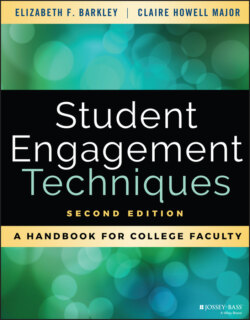Читать книгу Student Engagement Techniques - Elizabeth F. Barkley - Страница 66
The Psychomotor Domain and Memory
ОглавлениеThe psychomotor component is also evident in procedural memory, the memory responsible for recalling skills that you've learned over a long time. These kinds of memories are almost impossible to forget because your body and brain have worked so hard to create them. This is the memory that helps you remember how to play a musical instrument or throw a football or button the buttons on your shirt. Novice learners start out imitating the teacher or more advanced peers as they develop skills in taking notes, participating in discussions, and performing laboratory procedures. As they move toward being experts, they become increasingly capable of doing these well on their own, ultimately attaining an unconscious mastery of the skills and often even adapting them in ways that best meet their individual needs.
Acknowledging the role of the psychomotor domain in engagement may be a stretch for many academics, but “the doing” of the visible, auditory, and kinesthetic activities of active learning involve psychomotor skills. “Thinking” and “feeling” are internal, but they are expressed and often “worked out” through talking, writing, reading, and performing actions. At all stages of learning, students with learning styles that respond best to kinesthetic experiences will most be more engaged in learning tasks that incorporate aspects of the psychomotor domain. Finally, teachers know that even the most attentive and well-intended students cannot stay focused when they are sitting idly and physically inactive over long periods of time. Therefore, where possible and appropriate, effective, holistic engagement strategies add psychomotor dimensions, even if it is something as simple as getting students re-energized and refocused by having them stand up and move around the room to talk to each other or find partners for group work.
